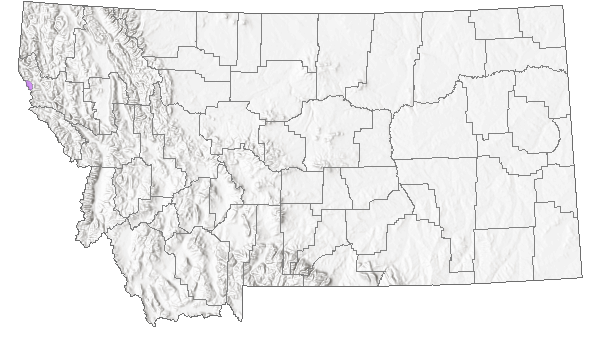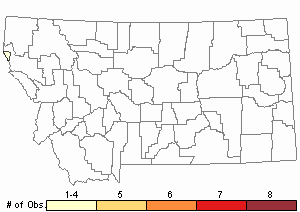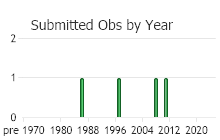View in other NatureServe Network Field Guides
NatureServe
Montana
Utah
Wyoming
Idaho
Wisconsin
British Columbia
South Carolina
Yukon
California
New York
Bloom Peak Douglasia - Douglasia conservatorum
Other Names:
Androsace conservatorum
State Rank Reason (see State Rank above)
Described as a new species in 2010 from a single location along the Idaho/Montana border. The population of this newly described species is apparently closely allied to Douglasia idahoensis, D. laevigata and D. nivalis (Bjork 2010). Additional research may be needed to determine if this population warrants recognition at the specific level or if it should be treated as conspecific with D. idahoensis or D. nivalis. However, the discovery of this population is significant in that it is a new addition to the state flora no matter if it is treated as a distinct species or as a population of one of the previously mentioned species.
- Details on Status Ranking and Review
Population Size
Score3 - Vey Small: Generally <2,000 individuals.
Range Extent
Score3 - Local Endemic or Very Small Montana Range: Generally restricted to an area <10,000 sq. miles (equivalent to the combined area of Phillips and Valley Counties) or <6 Sub-basins (4th code watersheds) Range-wide OR limited to one Sub-basin in Montana
Area of Occupancy
Score3 - Very Low: Generally occurring in 3 or fewer Subwatersheds (6th Code HUC’s).
Environmental Specificity
Score2 - High: Species is restricted to a highly specialized and limited habitat and is typically dependent upon unaltered, high-quality habitat (C Values of 8-10).
Trends
ScoreNA - Rank factor not assessed.
CommentTrends are unknown, though the habitat appears to be stable. Warming or drying trends may lead to declining population levels.
Threats
ScoreNA - Rank factor not assessed.
CommentHabitat is remote, though a forest road and informal parking area are adjacent to the population.
Intrinsic Vulnerability
Score1 - Moderate Vulnerability: Specific biological attributes, unusual life history characteristics or limited reproductive potential makes the species susceptible to extirpation from stochastic events or other adverse impacts to its habitat and slow to recover.
Raw Conservation Status Score
Score
12 total points scored out of a possible 13. (Rarity factors only).
General Description
Mat-forming. Scapes solitary, 12–30 mm long, stellate-pubescent. Leaves papillose, linear to linear-elliptic, 7–17 mm long. Inflorescence a bracteate umbel with 2 to 10 flowers. Flowers on pedicels 3-8 mm long, bractless; calyx pubescent; corolla 10-12 mm long, the 5 lobes 5–6 mm long. Capsule 2–3 mm long (
Lesica et al. 2012. Manual of Montana Vascular Plants. BRIT Press. Fort Worth, TX).
Phenology
Flowering during June.
Diagnostic Characteristics
Douglasia conservatorum can be distinguished from Montana's only other Douglasia species (D. montana) by its longer flowering stems (12-30 mm long vs. 5-20 mm) and the greater number of flowers on each stem (usually 3 or more vs. 1 to 2 in D. montana).
Species Range
Montana Range
Range Descriptions

 Native
Native
Range Comments
Currently thought to be restricted to a single location along the Idaho/Montana border.
Observations in Montana Natural Heritage Program Database
Number of Observations: 4
(Click on the following maps and charts to see full sized version)
Map Help and Descriptions
Relative Density

Recency



 (Observations spanning multiple months or years are excluded from time charts)
(Observations spanning multiple months or years are excluded from time charts)
Habitat
Open, subalpine ridges and slopes with shallow, gravelly soils (Bjork 2010).
Stewardship Responsibility
Threats or Limiting Factors
STATE THREAT SCORE REASON
Threat impact not assigned because threats are not known (MTNHP Threat Assessment 2021).
References
- Literature Cited AboveLegend:
 View Online Publication
View Online Publication Lesica, P., M.T. Lavin, and P.F. Stickney. 2012. Manual of Montana Vascular Plants. Fort Worth, TX: BRIT Press. viii + 771 p.
Lesica, P., M.T. Lavin, and P.F. Stickney. 2012. Manual of Montana Vascular Plants. Fort Worth, TX: BRIT Press. viii + 771 p. MTNHP Threat Assessment. 2021. State Threat Score Assignment and Assessment of Reported Threats from 2006 to 2021 for State-listed Vascular Plants. Botany Program, Montana Natural Heritage Program, Helena, Montana.
MTNHP Threat Assessment. 2021. State Threat Score Assignment and Assessment of Reported Threats from 2006 to 2021 for State-listed Vascular Plants. Botany Program, Montana Natural Heritage Program, Helena, Montana.
- Additional ReferencesLegend:
 View Online Publication
View Online Publication
Do you know of a citation we're missing? Bjork, C. R. 2010. Douglasia conservatorum (Primulaceae), a New Species from Idaho and Montana, U.S.A. NOVON 20:9-12.
Bjork, C. R. 2010. Douglasia conservatorum (Primulaceae), a New Species from Idaho and Montana, U.S.A. NOVON 20:9-12. Lesica, P., M.T. Lavin, and P.F. Stickney. 2022. Manual of Montana Vascular Plants, Second Edition. Fort Worth, TX: BRIT Press. viii + 779 p.
Lesica, P., M.T. Lavin, and P.F. Stickney. 2022. Manual of Montana Vascular Plants, Second Edition. Fort Worth, TX: BRIT Press. viii + 779 p.
- Web Search Engines for Articles on "Bloom Peak Douglasia"





